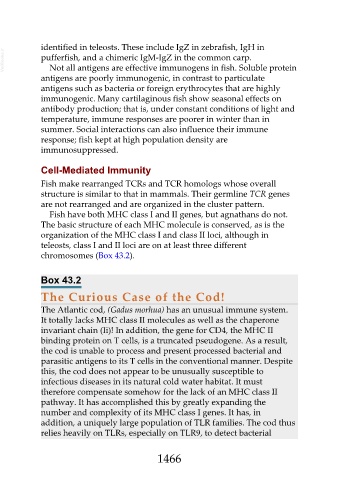Page 1466 - Veterinary Immunology, 10th Edition
P. 1466
identified in teleosts. These include IgZ in zebrafish, IgH in
VetBooks.ir pufferfish, and a chimeric IgM-IgZ in the common carp.
Not all antigens are effective immunogens in fish. Soluble protein
antigens are poorly immunogenic, in contrast to particulate
antigens such as bacteria or foreign erythrocytes that are highly
immunogenic. Many cartilaginous fish show seasonal effects on
antibody production; that is, under constant conditions of light and
temperature, immune responses are poorer in winter than in
summer. Social interactions can also influence their immune
response; fish kept at high population density are
immunosuppressed.
Cell-Mediated Immunity
Fish make rearranged TCRs and TCR homologs whose overall
structure is similar to that in mammals. Their germline TCR genes
are not rearranged and are organized in the cluster pattern.
Fish have both MHC class I and II genes, but agnathans do not.
The basic structure of each MHC molecule is conserved, as is the
organization of the MHC class I and class II loci, although in
teleosts, class I and II loci are on at least three different
chromosomes (Box 43.2).
Box 43.2
The Curious Case of the Cod!
The Atlantic cod, (Gadus morhua) has an unusual immune system.
It totally lacks MHC class II molecules as well as the chaperone
invariant chain (Ii)! In addition, the gene for CD4, the MHC II
binding protein on T cells, is a truncated pseudogene. As a result,
the cod is unable to process and present processed bacterial and
parasitic antigens to its T cells in the conventional manner. Despite
this, the cod does not appear to be unusually susceptible to
infectious diseases in its natural cold water habitat. It must
therefore compensate somehow for the lack of an MHC class II
pathway. It has accomplished this by greatly expanding the
number and complexity of its MHC class I genes. It has, in
addition, a uniquely large population of TLR families. The cod thus
relies heavily on TLRs, especially on TLR9, to detect bacterial
1466

